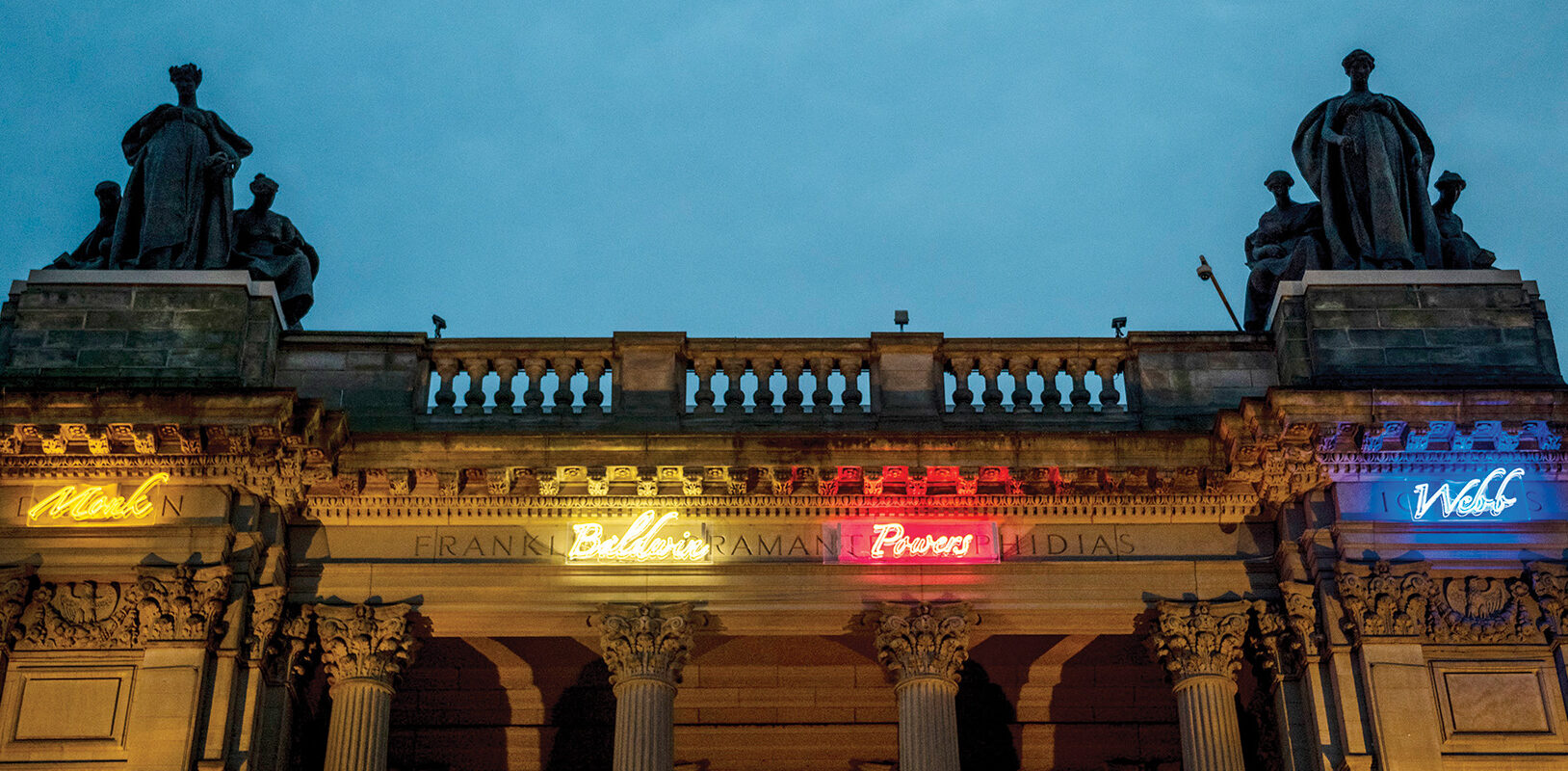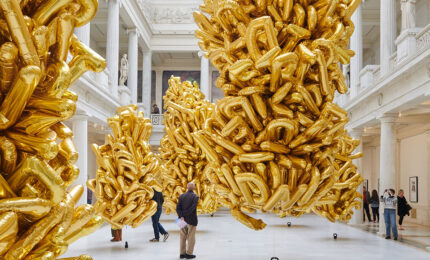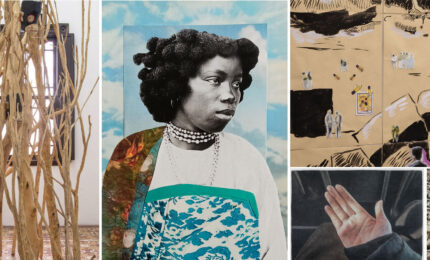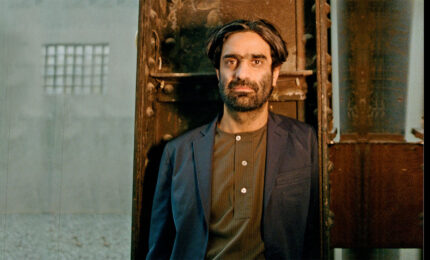Tavares Strachan knows how to light up the sky. In his native Nassau, Bahamas, he once launched glass rockets blown from local beach sand into the stratosphere using sugarcane as fuel. As fragments fell and crashed into the surf, he captured the event on film and collected the relics for display.
So when he stands inside Carnegie Museums’ Founder’s Room on a crisp October night, the crowd knows a performance by the artist, whose work tackles science, sociology, history, and technology, will be anything but boring.
“We’re going to have a good time,” Strachan tells them, his arms slicing through the air like a superhero, as he leads the group outside and along Forbes Avenue to the front of Carnegie Music Hall. Flanked by the darkened statues of Shakespeare and Bach, he begins.
“We are here tonight to honor the invisible,” Strachan proclaims. “May this solemnity that we now endeavor together be the alchemy that turns these invisibles visible.”
Then, right on cue, 54 names light up in neon on the fascia ribboning the building’s exterior, the glow causing the crowd to oooh and ahhh as they applaud.
Qiu. Henson. Tharpe. Chaminade.
Curious passersby looking up at the Day-Glo surnames will no doubt wonder—who are these people?
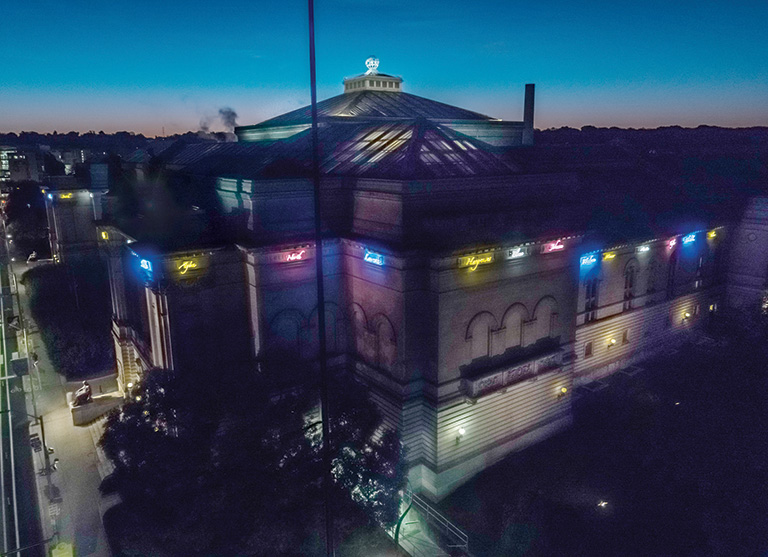
Tavares Strachan’s project extends around the building to Carnegie Library. Installation view, Tavares Strachan, The Encyclopedia of Invisibility, 2018, Courtesy of the artist. Photo: Steel Drone
For Strachan, that’s exactly the point—these artists, scientists, explorers, and other innovators nearly slipped through the cracks of history, but now he’s put their names in lights for the 57th edition of the Carnegie International
When Andrew Carnegie gave the massive sandstone building to the city of Pittsburgh in 1895, the names of Aristotle, Darwin, Leonardo, Mozart, and other accomplished men of literature, science, art, and music were etched into the fascia.
As the story goes and historic records confirm, Carnegie wasn’t happy that his favorite populist poet and fellow Scotsman Robert Burns didn’t make the cut; a building committee, not Carnegie, had the final say. “Some names have no business to be on the list,” Carnegie wrote in a letter in 1894. “Imagine Dickens in and Burns out.” That’s exactly what happened. So, in 1914, Carnegie and friends dedicated a statue to Burns outside of nearby Phipps Conservatory and Botanical Gardens, where it still stands today.
“Neon colors are like candy to me. It’s absurd. It’s playful. We are living in very serious times. In the process, we have lost our ability to play. When you are too serious, that’s kind of boring.”
– Tavares Strachan
Strachan came to town to shake up the list by adding a new set of names in neon script—among them, Matthew Alexander Henson, a black Arctic explorer who was among the first to reach the North Pole; Qiu Jin, a feminist poet and revolutionary who became known as “China’s Joan of Arc”; Sister Rosetta Tharpe, a queer black woman from Arkansas who was the godmother of rock ’n’ roll and the first gospel-singing sensation; and Cécile Chaminade, a prolific and much celebrated French composer and pianist. All told, the names of 54 cultural heroes have taken their rightful places next to the 110 permanent inhabitants of the building’s exterior. (The building’s first expansion, completed in 1907, allowed for 10 additional names.)
Strachan is not alone in transforming the shell of the building. In a major new commission, El Anatsui, a Ghanaian-born artist who lives in Nigeria, draped the 30-by-160-foot façade of Carnegie Museum of Art’s Scaife wing in a majestic and ever-changing sculpture fashioned from discarded liquor bottle tops and aluminum printing plates.
By remaking how we see the building’s exterior, says Ingrid Schaffner, curator of the Carnegie International, “anyone who passes by the museum is in the space of the Carnegie International. More than that, the works of Strachan and Anatsui are already working on our memory. After the exhibition closes, we will look up and see the ghosts of these magnificent works of art.”
Who is forgotten, and why?
Following the illumination of the names, Strachan reveals an unconventional history lesson using humor, theatrics, and a cast of performers. Timothy “Speed” Levitch, an exuberant actor and poet, leads the procession around the historic Oakland complex before introducing the stars of the performance—a group of children sporting white bomber jackets, each custom-made by Strachan and his mother.
The kids step up onto a literal soap box as they deliver their lines, filling in the gaps of history for the adults in the audience. “Tonight is an exciting night for this building. Tonight it gets a chance to express itself,” declares 11-year-old Kairi Bradshaw-Waters.
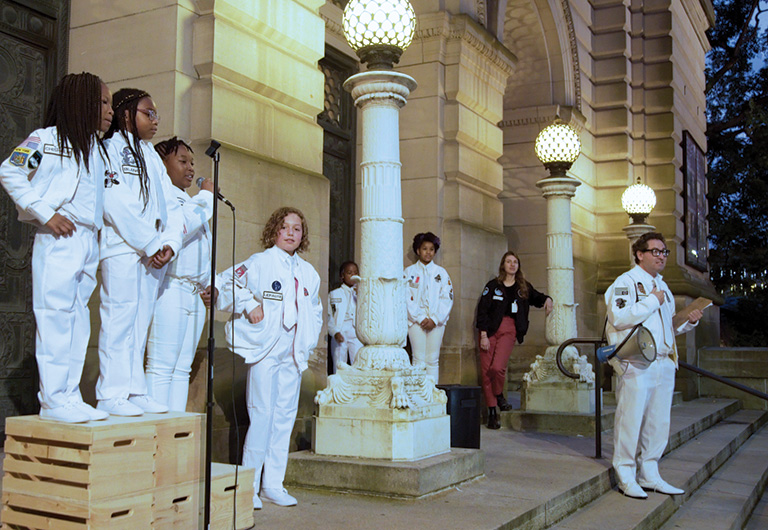
The young guides and Timothy “Speed” Levitch (far right) on the steps of Carnegie Music Hall.
“I think of Mary Cassatt. Mary was just a girl painter growing up on the North Side. How many times did she stand right here, look up, and ask, ‘Who are all these guys?!’” Naimah Bey, age 10, adds, “For nothing is written in stone. Except, of course, the names on this building.”
“Matthew Henson was the great African American explorer who helped guide the first team of explorers to stand on the North Pole,” continues Isla Bower, age 8. “This goes out to Henson’s soul, still out there exploring tonight. Welcome, my dear, we hope you’re enjoying your newest frontier.”
“The kids really dug in and tuned in. … They will remember this forever. That is why this work is so important.”
– janera solomon, executive director of Kelly Strayhorn Theater
Ten-year-old Thea Siegel shares the story of Nicole-Reine Lepaute, an 18th-century astronomer who correctly “predicted the return of Halley’s Comet, created her own catalog of the stars, and computed the positions of the planets, the sun, and the moon. Undoubtedly, Nicole’s soul is right now busily figuring out the exact trajectory of her neon sign’s shine.”
The young guides learned their lines and workshopped their performance—a close collaboration between the artist and Kelly Strayhorn Theater—in record time.
“The kids really dug in and tuned in,” says janera solomon, executive director of Kelly Strayhorn Theater. “They were so excited to know that an artist was going to make something, and they were going to be a part of it. When they saw the names for the first time during dress rehearsal, they yelled, ‘Look, look, look!’ They will remember this forever. That is why this work is so important.”
Strachan, who splits his time between the Bahamas and New York, is known for using neon to spread his art’s messages across barriers of time, space, race, and gender. “Neon colors are like candy to me. It’s absurd. It’s playful,” he says. “We are living in very serious times. In the process, we have lost our ability to play. When you are too serious, that’s kind of boring.”
For the past five years, Strachan has been compiling an Encyclopedia of the Invisible, a well-researched list of people, places, and things society has forgotten over time, some 2,800 pages worth and counting. A copy, from which the 55 names displayed on the building were drawn, is on view as part of the exhibition.
Strachan’s upbringing in the Bahamas gives him a particular perspective. For people “who grow up in small places, there is a sense of nowhereness. What happens when you are in the arts, dominated by people in New York and Berlin, and what does it mean to be an artist from an island?,” he asks. “You think about how society decides who is visible and part of the conversation. I think hard about getting people to think about things that are not immediately in front of them.”
For example, Strachan places Artemisia Gentileschi, one of the first female artists to have a broad impact on the art of her time, in between Beethoven and Mozart, while rapper Christopher Wallace, known as Biggie Smalls, fits between naturalist Alexander von Humboldt and scientist Roger Bacon.
At the end of the performance, Strachan says, “Imagine getting permission to drill into a 120-year-old building. But if you want to change history, that’s what it might take.”
Getting the necessary city permits to add neon-lit script onto the historic complex was indeed a time-consuming and complicated process that required permission from the city’s Historic Review Commission. Making sure not to impact the historical structure, Strachan and team spaced the new names between the existing ones, with the brackets holding each neon piece attached to mortar, not to stone. In fact, their glow illuminates the existing names and the architecture of the building.
“The neon scripts are here not to erase but to electrify your relationship to the museum,” Schaffner writes in her essay for The Guide to the exhibition.
Monumental collaboration
Soaring above the front entrance to Carnegie Museum of Art, the sculpture is just as El Anatsui imagined it: a new museum façade that “opens up space” for the existing Richard Serra sculpture, Carnegie, and forefronts a major new work of his own.
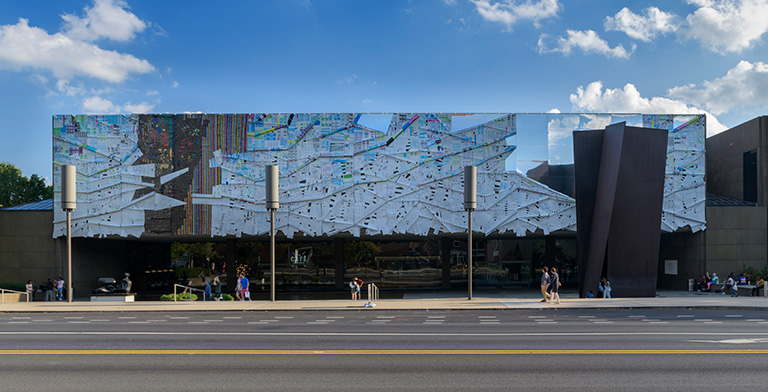
El Anatsui’s Three Angles blankets the façade of Carnegie Museum of Art, its mirrors pulling the sky into the building. Richard Serra’s steel sculpture, Carnegie, created for the 1985 Carnegie International, is in the foreground at right. Photo: Bryan Conley
Two years ago, when Schaffner invited Anatsui to participate in the Carnegie International, she hoped he would create one of his “monumental mantles”—his latest chapter of work fashioned from scraps of metal and created for historical sites around the world, from a palazzo in Venice to a palace ruin in Marrakech to the Royal Academy of Arts in London.
He agreed, but insisted on total artistic freedom. He would also need a fabricator, someone to actually assemble a massive work of art using materials mostly sourced from Pittsburgh. All of this in a compressed timeframe of nine weeks.
It was definitely a challenge, Schaffner says. Where would she find someone who could pull off such a considerable feat? Enter Dee Briggs, a sculptor based in Wilkinsburg who creates monumental sculpture in an old firehouse she converted into a home and studio.
When Anatsui came to Pittsburgh from Nigeria for a site visit in May, he met Briggs, and the two hit it off immediately. “We spoke the same language,” she says, “sculpture.”
“Anatsui transforms these objects and their historic references into works of tremendous freedom and potential.”
– Ingrid Schaffner, curator of the Carnegie International
Briggs took Anatsui on a tour of the city. From the top of the Duquesne Incline, the pair looked down from Mount Washington at the cityscape. Anatsui’s eye was drawn to the city streets, how they followed the course of the rivers, forming triangles instead of the right-angled grids of most cities. He decided to manipulate the printing plates to form the same sharp angles. “It was a spark,” he says.
While Anatsui worked on the enormous composition from his studio in Africa, Briggs was responsible for fabricating it. They got to work experimenting to create surfaces and textures by folding, crumpling, and stomping upon the aluminum plates donated by Knepper Press, a commercial press in Clinton, Pennsylvania. “It was great fun,” says Briggs.

Dee Briggs (background, far left) and crew raise one of the 20 vertical sections of the sculpture. Photo: Deonna DeVaughn
To make the project more manageable, the pair divided the sculpture into 20 vertical sections—each weighing between 100 and 150 pounds. “Dee was in her studio in Wilkinsburg, El in his in Nsukka, Nigeria,” says Schaffner, “directing and composing as they went along.”
To carry out the plan, Briggs erected a large white tent in her backyard and hired a crew of 21 people, many of them teenagers from her neighborhood as well as nearby Homewood and Braddock. “It was an intense and exhilarating summer job.”
To balance out the towering Serra sculpture, which is made of steel and stands nearly 40 feet high on one side of the museum’s front plaza, Anatsui opted for a vibrant pattern made of bottle caps from Nigeria on the other side. The vertical stripes, notes Anatsui, mirror the motion of the museum’s fountain.
“It is a historical reference,” Anatsui says of the bottle caps, a material he’s worked with since 2007 when he came across a discarded bag full of liquor bottle tops. He connected them to the trade history between Europe, America, and Africa that trafficked in sugar and rum but also in slaves. Mirrors, used by the artist to provide breathing room for the Serra, were also among the objects European traders brought to Africa. “Anatsui transforms these objects and their historic references into works of tremendous freedom and potential,” says Schaffner.
Depending on the weather and the onlooker’s perspective, Anatsui’s sculpture, titled Three Angles, changes. At any moment, the mirrors might reflect the Serra, the University of Pittsburgh’s nearby Cathedral of Learning, or even the clouds in the sky. On clear days, the printing plates turn a darker shade of blue, but they fade to a ghostly hue on a gray Pittsburgh day.
Anatsui says he couldn’t have pulled this project off without Briggs and her painstaking attention to detail. “She is a great, powerful woman.”
In turn, Briggs says she couldn’t have done it without her crew, many of whom are teens who spent the summer helping with every aspect of fabrication, from attaching the large panels to deer fencing using zip ties to putting specialty tape on the back of the printing plates.
Some had never visited Carnegie Museum of Art. Deonna DeVaughn, 15, made her first visit to see the sculpture installed on the front of the building, and was photographed with Anatsui in October. “Never in my life would I have guessed I would help make something like this,” she says, proud of the work that hangs in front of her. “It’s bigger than I thought it would be.”
“We spoke the same language—sculpture.” – Dee Briggs
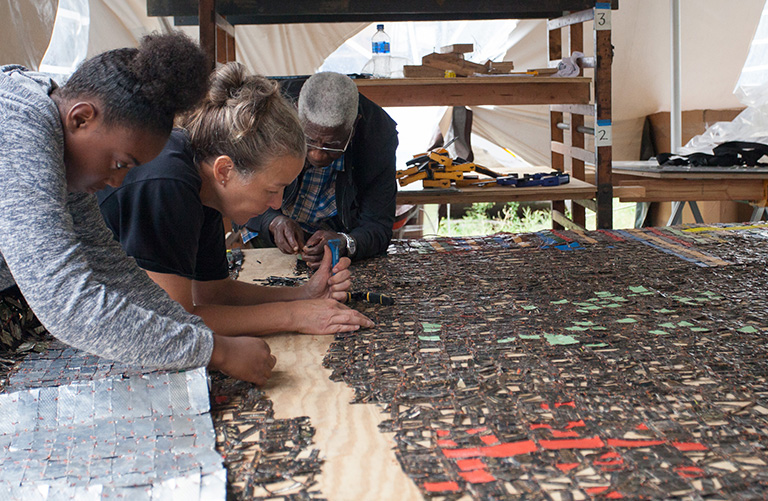
Dee Briggs (center), 15-year-old Deonna DeVaughn, and El Anatsui attach sections of bottle caps shipped from Anatsui’s studio in Nsukka. Photo: Natalia Gomez
Her cousin, 16-year-old Nautica Jones, loved her summer job experience, too. “Miss Dee taught me how to use new tools.”
Staring up at the printing plates, the girls recall the many days they spent placing double-sided tape on the backside of the plates inked with the Steelers schedule and other colorful printed matter. They point up at the mirrors, catching the Serra in the reflection.
“Anatsui’s work shows us what a sculpture this building is,” Schaffner says. “Just as Richard Serra did with Carnegie in 1985, El Anatsui has underscored the beauty and monument of the museum with this work.”
The Carnegie International, 57th Edition, 2018, presented by Bank of America, is made possible with major support from the Carnegie International Endowment, The Fine Foundation, and the Keystone Members of the 2018 Carnegie International. Additional support is provided by the Friends of the 2018 Carnegie International, the Jill and Peter Kraus Endowment for Contemporary Art, the National Endowment for the Arts, the EQT Foundation, The Fellows of Carnegie Museum of Art, and the Louisa S. Rosenthal Family Fund.

THE ENCYCLOPEDIA OF INVISIBILITY
Oscar Zeta Acosta (1935–1974)
Chicano activist-attorney and novelist best known as the inspiration for Hunter Thompson’s Dr. Gonzo.
Ahmad Baba al Massufi (1556–1627)
Medieval Sanhaja Berber scholar and political provocateur in western Sudan.
Gustavo Ayón (Born 1985)
Mexican professional basketball player who represents the senior Mexican national basketball team.
Sara Josephine Baker (1873–1945)
American physician notable for making contributions to public health, especially within immigrant communities of New York City.
James Baldwin (1924–1987)
American novelist and social critic whose essays explore the intricacies of racial, sexual, and class distinctions in Western societies.
Benjamin Banneker (1731–1806)
African American mathematician and astronomer who built the first striking clock in America.
Charlotta Bass (1874–1969)
An American educator, publisher- editor, and civil rights activist, Bass was the first African American woman to own and operate a
newspaper in the U.S.
Mel Blanc (1908–1989)
American voice actor, radio com-edian, and recording artist known as “The Man of a Thousand Voices.”
Cécile Chaminade (1857–1944)
French female composer and pianist known chiefly for her piano music.
Shirley Chisholm (1924–2005)
The first African American woman in Congress, where she served seven terms. In 1972, she campaigned for the Democratic presidential nomination.
Dorothea Dix (1802–1887)
American activist during the Civil War who sought humane treatment for the mentally ill and created one of America’s first mental institutions.
Shirin Ebadi (Born 1947)
2003 Nobel Peace Prize recipient. Author and legal/human rights scholar who was a judge in her native Iran before the 1979 Islamic Revolution.
Jane Elliott (Born 1933)
Schoolteacher, activist, diversity educator, and feminist known for her “blue eyes-brown eyes” exercise, which allowed students to experience the feeling of discrimination.
Margaret Fell (Margaret Fox) (1614–1702)
Quaker writer and philosopher, known as a feminist pioneer after writing Womens Speaking Justified, which defended a woman’s right to preach.
Maria Elizabeth Smith Fernald (1839–1919)
American entomologist who wrote the major reference book A Catalogue of the Coccidae of the World, which enumerated more than 1,500 species.
Anna Lee Tingle Fisher (Born 1949)
American chemist, emergency physician, and NASA astronaut.
James Ford (1893–1957)
Activist and politician who interpreted communist ideology as it pertained to black communities.
Rosalind Franklin (1920–1958)
English chemist and X-ray crystallographer who made contributions to the understanding of the molecular structures of DNA, RNA, viruses, coal, and graphite.
Artemisia Gentileschi (1593–1652/53)
Italian baroque painter who depicted strong women in biblical and mythological scenes. She became known for her participation in the prosecution of her rapist and was tortured to prove the veracity of her claims.
Alison Hargreaves (1962–1995)
A British mountain climber, Hargreaves scaled Mount Everest alone in 1995 and was the first to solo all the great north faces of the Alps in a single season.
Robert Hayden (1913–1980)
A poet, essayist, and educator, Hayden was the first African American to serve in the role known today known as U.S. Poet Laureate.
Matthew Henson (1866–1955)
African American explorer who accompanied Robert Peary on seven voyages to the Arctic over 23 years. Reached the North Pole in 1909.
Aemilia Hilaria (ca. 300 CE–363 CE)
Gallo-Roman physician who practiced medicine and wrote books on gynecology and obstetrics.
Jack Johnson (1878–1946)
The first African American heavyweight boxing champion. In 2018, Johnson received a posthumous presidential pardon for his 1913 conviction for violating a Jim Crow-era law that made it illegal for him to transport a white woman across state lines.
Kassiani (805–865 A.D.)
One of the first female composers and one of only two Byzantine women to have written in her own name during the Middle Ages.
Hilma af Klint (1862–1944)
Swedish artist considered to be a pioneer of abstract painting.
Hedy Lamarr (1914–2000)
While best known for her film career, the Hollywood actress was also a pioneer in the field of wireless communications and the co-inventor of spread spectrum technology.
Robert Henry Lawrence, Jr. (1935–1967)
U.S. Air Force officer and the first African American astronaut, Lawrence was killed in the crash of an F-104 Starfighter at Edwards Air Force Base.
Nicole-Reine Lepaute (1723–1788)
French astronomer and mathematician known for her prediction of the return of Halley’s Comet.
Malcolm X (1925–1965)
American Muslim minister and human rights activist who is considered to be one of the most influential African Americans in history.
Bruno Manser (1954–2005)
Swiss environmental activist who fought for rainforest preservation and the rights of indigenous peoples.
Thelonious Monk (1917–1982) American jazz pianist with a unique improvisational style. He was the second most recorded jazz composer after Duke Ellington.
Moondog (Louis Thomas Hardin) (1916–1999)
American composer and poet who invented several instruments. He was blind and a familiar figure on New York City streets in the 1950s—60s.
Tenzing Norgay (1914–1986)
A Nepali-Indian Sherpa mountaineer, and one of the first two people known to reach the summit of Mount Everest, along with Edmund Hillary, on May 29, 1953.
Marianne North (1830–1890)
Victorian trailblazer and pioneering botanical artist.
Edith Marion Patch (1876–1954)
An American entomologist, in 1904 she became the head of entomology at the University of Maine.
Lynden Oscar Pindling (1930–2000)
Regarded as the “Father of the Nation” of the Bahamas, having led it to majority rule in 1967 and to independence in 1973. Served as prime minister from 1967–1992.
Agnes Luise Wilhelmine Pockels (1862–1935)
German pioneer in chemistry best known for establishing surface science.
Harriet Powers (1837–1910)
Former slave, folk artist, and quilt maker from rural Georgia who recorded local legends, Bible stories, and astronomical events on her quilts.
Qiu Jin (1875–1907)
Chinese revolutionary, feminist, and writer. Qiu, who was executed, is considered a national heroine in China.
Haile Selassie (1892–1975)
Ethiopia’s regent and emperor who also served as chairperson of the Organization of African Unity.
Tupac Shakur (1971–1996)
American rapper and actor who sold more than 75 million records worldwide.
Sister Nancy (Ophlin Russell) (Born 1962)
Jamaican dancehall DJ and singer best known for the reggae anthem “Bam Bam.”
Robert Smalls (1839–1915)
African American slave who became a naval hero and politician.
Margaret Chase Smith (1897–1995)
As a Republican representing Maine, Smith was the first woman to serve in both houses of the United States Congress. She is best known for her 1950 speech the “Declaration of Conscience” championing free speech.
Sombath Somphone (Born 1952)
Internationally acclaimed community development worker and prominent member of Lao civil society. He was abducted by police in 2012 and has not been seen since.
George Edwin Taylor (1857–1925)
A newspaper writer-editor who in 1904 became the first African American selected by a political party to be its candidate for the presidency of the United States.
Sister Rosetta Tharpe (1915–1973)
Black singer, songwriter, guitarist, and the “Godmother of Rock ’n’ Roll,” first known for her gospel recordings.
Christopher Wallace (Biggie Smalls) (1972–1997)
Considered one of the best rappers of all time and a central figure in the East Coast hip-hop scene.
Martha Beatrice Webb (1858–1943)
English sociologist, economist, socialist, labor historian, and social reformer. Coined the term “collective bargaining.”
Nathaniel Thomas Wilson (Kool G Rap) (Born 1968)
Considered one of the most influential American rappers and an inspiration for some of hip-hop’s most acclaimed figures.
Christa Winsloe (1888–1944)
20th-century German-Hungarian novelist, playwright, and sculptor.
Francesca Woodman (1958–1981)
American photographer best known for her black-and-white pictures featuring herself or female models.
Rosalyn Yalow (1921–2011)
Inventor of radioimmunoassay (RIA), a tool for determining minute substances in the urine and blood, and a joint recipient of the 1977 Nobel Prize in Physiology or Medicine.
Full entries appear in Tavares Strachan’s Encyclopedia of the Invisible, a collection that is currently 2,800 pages long and growing.
